About the Author
As a dedicated physiotherapist specializing in postural correction techniques in Surrey, BC, I am committed to helping individuals improve their posture, alleviate pain, and enhance overall well-being. With a focus on evidence-based practices and personalized care, I strive to provide comprehensive support to individuals seeking to address postural issues. In this article, I will explore physiotherapy solutions for postural correction in Surrey, BC.
Maintaining good posture is essential for overall health and well-being, as it contributes to proper alignment of the spine, reduces the risk of musculoskeletal injuries, and promotes optimal function of the body. In Surrey, BC, physiotherapy offers effective solutions for postural correction, focusing on exercises, techniques, and interventions to improve posture and alleviate associated symptoms. In this article, I will delve into postural correction techniques in Surrey, BC, and discuss their importance for individuals seeking to achieve better posture and overall health.
Understanding Postural Issues
Poor posture can result from various factors, including prolonged sitting, repetitive movements, muscle imbalances, and structural abnormalities. Common postural issues include forward head posture, rounded shoulders, excessive curvature of the spine, and anterior pelvic tilt. These postural abnormalities can lead to muscle tightness, weakness, joint stiffness, and pain in the neck, shoulders, back, and hips. Physiotherapy plays a crucial role in identifying and addressing these postural issues through targeted interventions and exercises.
Postural Assessment and Analysis
The first step in postural correction is a thorough assessment and analysis of an individual’s posture by a physiotherapist specializing in postural rehabilitation. During the assessment, the physiotherapist evaluates the individual’s standing, sitting, and walking posture, identifying any deviations from the ideal alignment. They also assess muscle strength, flexibility, joint range of motion, and functional movement patterns to determine contributing factors to poor posture. Based on this assessment, a customized treatment plan is developed to address the specific postural issues and underlying causes.
Postural Correction Exercises
Postural correction exercises are key components of physiotherapy treatment for improving posture and addressing muscle imbalances. These exercises target specific muscle groups to strengthen weak muscles, stretch tight muscles, and promote proper alignment of the spine and joints. Common postural correction exercises include:
- Core Strengthening Exercises: Core muscles play a crucial role in maintaining good posture and providing stability to the spine. Core strengthening exercises, such as planks, bridges, and abdominal crunches, help strengthen the muscles of the abdomen, lower back, and pelvis, promoting better spinal alignment and posture.
- Upper Back Strengthening Exercises: Strengthening the muscles of the upper back, including the rhomboids, trapezius, and rear deltoids, can help improve posture by pulling the shoulders back and preventing rounding of the shoulders. Exercises such as rows, reverse flyes, and shoulder blade squeezes target these muscles, promoting better shoulder alignment and posture.
- Stretching Exercises: Stretching tight muscles is essential for improving flexibility, reducing muscle tension, and alleviating postural issues. Stretching exercises target muscles that commonly become tight due to poor posture, such as the chest, shoulders, hip flexors, and hamstrings. Stretching these muscles helps restore balance to the body and promote better posture.
- Postural Awareness Exercises: Postural awareness exercises focus on improving body awareness and promoting proper alignment during daily activities. These exercises involve practicing correct posture while sitting, standing, walking, and performing functional movements. By increasing awareness of posture and body positioning, individuals can develop healthier habits and maintain better posture throughout the day.
Manual Therapy Techniques
Manual therapy techniques are often used in conjunction with exercises to address postural issues and promote better alignment of the spine and joints. These techniques may include:
- Joint Mobilizations: Gentle joint mobilization techniques are used to improve joint mobility, reduce stiffness, and promote better alignment of the spine and extremities.
- Soft Tissue Mobilization: Soft tissue mobilization techniques, such as massage, myofascial release, and trigger point therapy, help release muscle tension, reduce adhesions, and improve tissue flexibility, supporting postural correction efforts.
- Manual Stretching: Manual stretching techniques performed by the physiotherapist help elongate tight muscles, improve flexibility, and restore proper muscle length-tension relationships, facilitating better posture and movement.
Postural Education and Ergonomic Advice
Postural education and ergonomic advice are essential components of physiotherapy treatment for postural correction. Physiotherapists in Surrey provide individuals with valuable information about proper posture, body mechanics, and ergonomic principles to apply in various settings, such as workstations, driving, and recreational activities. By teaching individuals how to maintain good posture and make ergonomic adjustments, physiotherapists empower them to prevent postural issues and promote musculoskeletal health in their daily lives.
Postural Bracing and Supportive Devices
In some cases, postural bracing or supportive devices may be recommended to aid in postural correction and provide additional support to the spine and surrounding structures. These devices, such as posture braces, lumbar supports, and ergonomic seating, help maintain proper alignment, reduce muscle fatigue, and alleviate discomfort associated with poor posture. Physiotherapists in Surrey assess individuals’ needs and provide guidance on the appropriate use of these devices to support their postural correction efforts.
Interdisciplinary Collaboration and Holistic Care
Interdisciplinary collaboration and holistic care are integral aspects of postural correction in Surrey, BC. Physiotherapists work closely with other healthcare professionals, such as chiropractors, massage therapists, and ergonomic specialists, to provide comprehensive care and address all aspects of an individual’s postural issues. By collaborating with other members of the healthcare team, physiotherapists ensure a holistic approach to postural correction, addressing physical, biomechanical, and psychosocial factors contributing to poor posture and musculoskeletal dysfunction.
Conclusion
Postural correction is essential for maintaining musculoskeletal health, preventing injuries, and promoting overall well-being. In Surrey, BC, physiotherapy offers effective solutions for addressing postural issues and promoting better alignment of the spine and joints. Through a combination of exercises, manual therapy techniques, postural education, and interdisciplinary collaboration, physiotherapists help individuals achieve optimal posture and improve their quality of life. If you or someone you know is struggling with poor posture, I encourage you to explore the benefits of physiotherapy and discover how it can help you achieve better posture and musculoskeletal health.
As a physiotherapist specializing in postural correction techniques in Surrey, BC, I am dedicated to helping individuals improve their posture, alleviate pain, and enhance overall well-being. If you or someone you know is seeking to address postural issues and improve musculoskeletal health, I invite you to reach out and explore how our comprehensive approaches and personalized care can support your postural correction journey. Together, we can work towards achieving better posture and enjoying a healthier, more active lifestyle. Browse around this site







